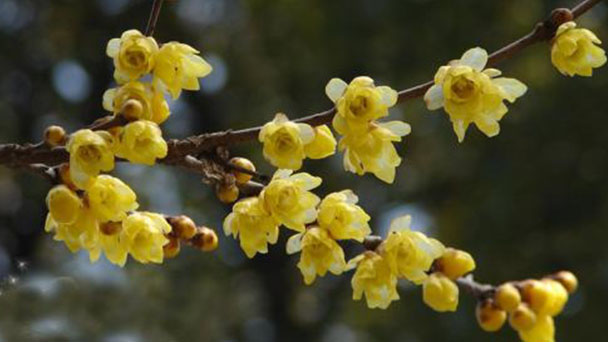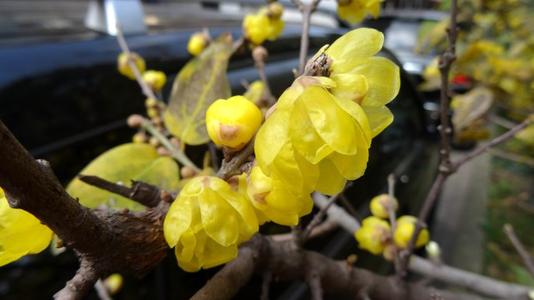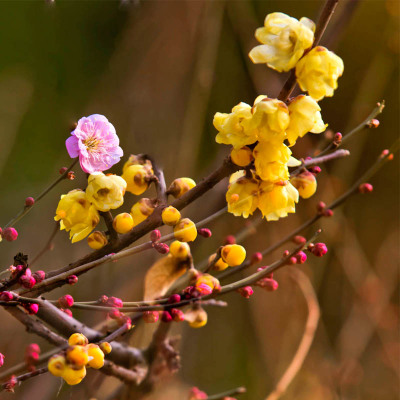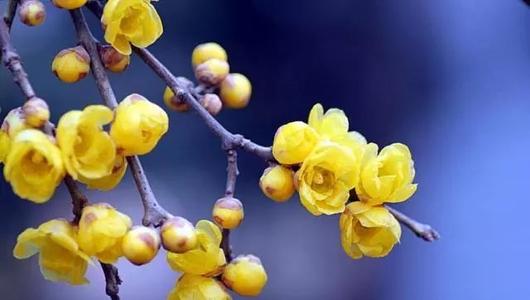Chimonanthus praecox profile
Written by Maggie
Mar 23 2021

Chimonanthus praecox, also known as wintersweet or Japanese allspice, is a species of flowering plant in the genus Chimonanthus of the family Calycanthaceae, native to China.
Chimonanthus Praecox picture
Chimonanthus Praecox morphological characteristics
Chimonanthus Praecox is a deciduous shrub, reaching up to 4 meters; Young branches square, old branches sub cylindrical, grayish brown, glabrous or sparsely glabrous, lenticellata; The buds are usually in the axils of the second year branches. The buds are suborbicular, imbricate, and pubescent. Leaves are papery to subleathery, ovoid, elliptic, broadly elliptic to ovate-elliptic, sometimes oblong-lanceolate, 5-25 cm long, 2-8 cm wide, apically acute to acuminate, sometimes caudate, basally acute to rounded, glabrous except on dorsal veins. Flowers born in the axils of the second year branches and leaves, flowers first, fragrant, 2-4 cm in diameter; Tepals are orbicular, oblong, obovate, elliptic or spatulate, 5-20 mm long, 5-15 mm wide, glabrous, internal tepals shorter than external tepals, base clawlike; Stamens are 4 mm, filaments longer or equal than anthers, anthers inward-curved, glabrous, septum apically short, staminodes 3 mm; chimonanthus praecox carpel base is sparsely hirsute, style up to 3 times ovary long, base glabrous. Frustules are sublignified, altar or ovate-elliptic, 2-5 cm long, 1-2.5 cm in diam., mouth constricted, with drill like lanceolate appendages. Flowering period is from November to March of the following year, fruiting from April to November.
Chimonanthus Praecox growth habit
Chimonanthus Praecox, one of the most prized prune breeds, is highly adaptable and prefers wet and sunny conditions. chimonanthus Praecox likes loose, deep, well drained, neutral or slightly acidic sandy loam. The suitable temperature for growth is 10-15℃. Winter tolerance of -15℃ low temperature, but flowering in -10℃ low temperature, open flowers will be damaged by freezing. Chimonanthus Praecox has strong branch, resistant to pruning.
Chimonanthus Praecox geographical distribution
Chimonanthus Praecox is found wild in Shandong, Jiangsu, Anhui, Zhejiang, Fujian, Jiangxi, Hunan, Hubei, Henan, Shaanxi, Sichuan, Guizhou, Yunnan, etc.Guangxi, Guangdong and other provinces are cultivated.Born in mountain forests.Japan, Korea and Europe, the Americas are introduced cultivation.Specimens of this type were collected from China.

Chimonanthus Praecox Garden Application
Chimonanthus Praecox shows the Chinese nation's unyielding character in the face of violence. It gives people spiritual enlightenment and beauty enjoyment. It is conducive to garden planting, and suitable for making ancient pile bonsai, flower arrangement and plastic arts, is the ideal winter flowers and precious trees. It is more widely used in urban and rural landscape construction.
(1) Flake planting, forming Chimonanthus Praecox flower forest. This kind of planting has the characteristics of a large area, many varieties and long flowering period. It is a place for people to visit for relaxation and fitness.
(2) Main landscape configuration refers to the landscaping configuration at the front entrance, both sides of the building and the central flower bed. Chimonanthus Praecox serves as the main scene, and with asparagus fern or other evergreen flowers, it forms an interesting and unique landscape with yellow flowers and red fruits.
(3) Mixed planting configuration usually adopts the mixed planting of tree species to form the mixed configuration of irrigation and Joe of different levels and species. The flower bed with natural height matching, patchwork, pose, color and color, has the characteristics of multi-species, multi-level and long flowering.
(4) Landscape through windows is a major feature of landscape architecture in South China. Arrange evergreen or deciduous trees under Windows.
(5) Rock, rockery configuration. Chimonanthus Praecox with rocks and rockery also has its merits. For example, Chimonanthus Praecox is used as the main scenery in the Zijing Mountain Park in Zhengzhou city, Henan Province. The matching lining of osmanthus, Cypress and emerald bamboo makes the scenery beautiful and lovely.

Latest Updated
- Benefits of Bugleweed - 7 Science-backed Health Benefits
- Bugleweed Dangers & Side Effects - Is It Poisonous?
- How to Plant Evergreen Trees - What You Should Know
- When to Plant Evergreens - Grow Guide for Evergreen Trees
- 12 Wonderful Evergreen Shrubs for Your Garden
- 12 Popular Evergreen Plants with Pictures for Beginners
- When And How To Prune A Lilac Bush Like a Pro
- How to Grow & Care for Lilac Vine (Hardenbergia Violacea)
- Japanese Lilac Tree (Syringa Reticulata) Care & Propagation Guide
- Shumard Oak Pros and Cons - What to Know
Popular Articles
- Winter maintenance of Antirrhinum Majus
- How to Grow Terminalia Mantaly Tree
- How to Grow and Care for Crossostephium Chinense
- How to grow Antirrhinum Majus in spring
- Peristeria Elata (Dove Orchid) Profile: Info & Care Guide
- Underwatered Snake Plant (Sansevieria Trifasciata) - Signs And How To Fix
- How to Care for Brazilian Jasmine Plant (Mandevilla Sanderi)
- How to Grow & Care for Graptopetalum Purple Delight in Summer
- Rosa Chinensis (China Rose): Plant Growing & Care Tips
- How to Care for Baby Sun Rose (Aptenia Cordifolia)
